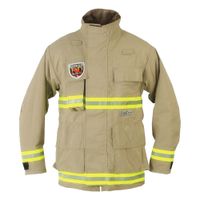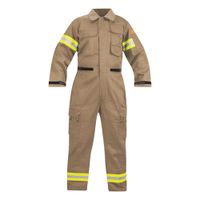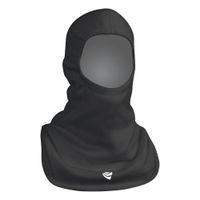Call +(254) 703 030 000 / 751 483 999 / 721 704 777
- Home
- Security
- Military Tactical Public Security Equipment
- Firefighting Clothing Rescue Equipment
- Firefighting Extrication Clothing
.....Read More
Frequently Asked Questions
What materials are firefighting clothing made from?
Firefighting clothing is primarily made from materials designed to provide thermal protection, durability, and comfort. The key materials include:
1. **Aramid Fibers**: These are synthetic fibers known for their heat resistance and strength. Kevlar and Nomex are the most common aramid fibers used in firefighting gear. Kevlar provides strength and cut resistance, while Nomex offers excellent thermal protection and flame resistance.
2. **PBI (Polybenzimidazole)**: PBI fibers are known for their exceptional thermal and chemical stability. They do not burn in air, and they maintain their integrity even at high temperatures, providing superior protection against heat and flames.
3. **Basofil**: This is a melamine-based fiber that offers good thermal protection and is often blended with other fibers to enhance the overall performance of the fabric.
4. **Modacrylic**: These fibers are flame-resistant and are often used in blends to improve the comfort and flexibility of the fabric.
5. **FR Cotton**: Flame-resistant cotton is treated with chemicals to enhance its fire-retardant properties. It is often used in station wear or undergarments for added comfort.
6. **Moisture Barriers**: Materials like Gore-Tex or Crosstech are used as moisture barriers in firefighting clothing. They provide waterproofing while allowing moisture vapor to escape, keeping the firefighter dry and comfortable.
7. **Thermal Liners**: These are often made from quilted layers of aramid fibers and other insulating materials to provide additional thermal protection and comfort.
These materials are combined in multiple layers to create turnout gear that protects firefighters from extreme heat, flames, and hazardous environments while allowing for mobility and breathability.
How do firefighting suits protect against heat and flames?
Firefighting suits, also known as turnout gear or bunker gear, protect against heat and flames through a multi-layered design that incorporates advanced materials and technology. The outer shell is typically made from flame-resistant materials like Nomex or Kevlar, which provide a primary barrier against flames and resist melting or igniting. This layer is also treated to repel water and chemicals, enhancing protection in various hazardous environments.
Beneath the outer shell is a moisture barrier, often made from materials like Gore-Tex or Crosstech. This layer prevents water, steam, and other liquids from penetrating the suit, which is crucial for maintaining the firefighter's body temperature and preventing steam burns. It also allows sweat to escape, helping to regulate body temperature and prevent heat stress.
The innermost layer is the thermal liner, which is designed to insulate against extreme heat. Made from materials like quilted aramid fibers, this layer traps air, providing thermal insulation that slows the transfer of heat to the firefighter's body. This is essential for allowing firefighters to operate in high-temperature environments for extended periods without succumbing to heat exhaustion or burns.
Additionally, firefighting suits are designed to be durable and flexible, allowing for a full range of motion while maintaining protection. Features like reinforced knees, elbows, and seams enhance durability, while reflective strips improve visibility in low-light conditions.
Overall, the combination of flame resistance, moisture protection, and thermal insulation, along with ergonomic design, ensures that firefighting suits provide comprehensive protection against the intense heat and flames encountered in firefighting operations.
What is the difference between firefighting coveralls and turnout gear?
Firefighting coveralls and turnout gear are both essential protective clothing for firefighters, but they serve different purposes and are designed for different situations.
Firefighting Coveralls:
1. **Purpose**: Primarily used for wildland firefighting or non-structural fire situations.
2. **Material**: Made from lightweight, flame-resistant materials like Nomex or Kevlar, providing protection against heat and flames while allowing for mobility and comfort.
3. **Design**: Typically a one-piece suit that covers the entire body, including arms and legs, with a snug fit to prevent snagging.
4. **Features**: May include pockets for tools, reflective strips for visibility, and ventilation for breathability.
5. **Protection Level**: Offers basic protection against heat and flames but is not suitable for high-temperature environments like structural fires.
Turnout Gear:
1. **Purpose**: Designed for structural firefighting, providing maximum protection in high-temperature environments.
2. **Material**: Constructed from multiple layers, including an outer shell, moisture barrier, and thermal liner, often using materials like PBI, Kevlar, or Nomex.
3. **Design**: Consists of separate jacket and pants, allowing for flexibility and ease of movement, with reinforced areas for durability.
4. **Features**: Includes thermal insulation, moisture resistance, and additional padding, with features like wristlets, storm flaps, and drag rescue devices.
5. **Protection Level**: Offers comprehensive protection against extreme heat, flames, and hazardous conditions encountered in structural fires.
In summary, firefighting coveralls are suited for less intense fire situations, offering mobility and basic protection, while turnout gear is essential for structural firefighting, providing robust protection against severe heat and hazardous conditions.
How often should firefighting clothing be replaced?
Firefighting clothing should be replaced based on several factors, including wear and tear, exposure to hazardous conditions, and compliance with safety standards. Generally, the National Fire Protection Association (NFPA) recommends that structural firefighting gear be replaced every 10 years, regardless of its condition, to ensure safety and compliance with the latest standards. However, this is a maximum lifespan, and gear may need to be replaced sooner if it shows signs of damage or degradation.
Regular inspections are crucial in determining the condition of firefighting clothing. Gear should be inspected after each use and undergo a more thorough inspection at least annually. Look for signs of wear such as tears, burns, or thinning fabric, as well as damage to reflective trim, closures, and seams. If any of these issues are present, the gear should be repaired or replaced immediately.
Exposure to extreme heat, chemicals, or biological contaminants can also necessitate more frequent replacement. If the gear has been exposed to such conditions, it should be evaluated for damage and decontaminated according to manufacturer guidelines. If decontamination is not possible or effective, replacement is necessary.
Additionally, changes in standards or technology may prompt earlier replacement. New materials and designs can offer improved protection, comfort, and functionality, making it beneficial to upgrade gear before the 10-year mark.
Ultimately, the decision to replace firefighting clothing should prioritize the safety and protection of the firefighter, taking into account the gear's condition, exposure history, and compliance with current safety standards. Regular training and awareness of the latest guidelines can help ensure that gear is replaced at the appropriate time.
What standards do firefighting clothing need to meet?
Firefighting clothing must meet several standards to ensure the safety and effectiveness of firefighters. These standards are primarily set by organizations such as the National Fire Protection Association (NFPA) and the International Organization for Standardization (ISO).
1. **NFPA 1971**: This standard specifies the minimum requirements for structural firefighting protective clothing. It covers the design, performance, testing, and certification of turnout gear, including coats, pants, helmets, gloves, and footwear. Key aspects include thermal protection, flame resistance, and water penetration resistance.
2. **NFPA 1977**: This standard applies to protective clothing and equipment for wildland firefighting. It emphasizes lightweight, breathable materials that provide protection against heat, flames, and environmental hazards while allowing for mobility and comfort.
3. **ISO 11613**: This international standard specifies the general performance requirements for protective clothing used in firefighting. It includes tests for heat and flame resistance, mechanical protection, and ergonomic design.
4. **EN 469**: This European standard outlines the performance requirements for protective clothing used in firefighting. It focuses on thermal insulation, resistance to water penetration, and breathability.
5. **Material Requirements**: Firefighting clothing must be made from materials that provide thermal insulation, flame resistance, and durability. Common materials include Nomex, Kevlar, and PBI, which offer high resistance to heat and flames.
6. **Visibility and Identification**: Standards require high-visibility features such as reflective strips to ensure firefighters are easily seen in low-light conditions.
7. **Ergonomics and Comfort**: The design must allow for a full range of motion and comfort during extended use. This includes considerations for fit, weight distribution, and breathability.
8. **Testing and Certification**: Firefighting clothing must undergo rigorous testing to ensure compliance with these standards. Certification by recognized bodies is essential for verifying that the gear meets all safety requirements.
How do you properly maintain and clean firefighting gear?
Inspect gear regularly for damage or wear. Follow manufacturer guidelines for cleaning. Use mild detergent and warm water for washing. Avoid bleach or fabric softeners. Hand wash or use a front-loading machine on a gentle cycle. Rinse thoroughly to remove detergent residue. Air dry in a well-ventilated area, away from direct sunlight or heat sources. Clean helmets with mild soap and water; inspect for cracks or damage. Check and clean face shields and visors. Clean boots with water and mild soap; inspect for wear and replace if necessary. Clean gloves according to manufacturer instructions. Store gear in a cool, dry place, away from contaminants. Regularly inspect and maintain all closures, straps, and fasteners. Follow NFPA standards and department protocols for maintenance.
What additional protective equipment do firefighters use besides clothing?
In addition to their protective clothing, firefighters use a variety of equipment to ensure their safety and effectiveness in hazardous environments. Key protective equipment includes:
1. **Self-Contained Breathing Apparatus (SCBA):** This device provides breathable air in smoke-filled or toxic environments, allowing firefighters to work safely without inhaling harmful substances.
2. **Helmets:** Firefighter helmets are designed to protect against falling debris, heat, and electrical hazards. They often include face shields or goggles for additional eye protection.
3. **Gloves:** Fire-resistant gloves protect hands from heat, sharp objects, and other hazards while maintaining dexterity for handling equipment.
4. **Boots:** Firefighter boots are made from heat-resistant materials and provide protection against punctures, slips, and electrical hazards.
5. **Hearing Protection:** In environments with high noise levels, such as near machinery or during explosions, firefighters use earplugs or earmuffs to prevent hearing damage.
6. **Personal Alert Safety System (PASS):** This device emits a loud alarm if a firefighter remains motionless for a certain period, helping locate and rescue incapacitated personnel.
7. **Thermal Imaging Cameras (TICs):** These devices help firefighters see through smoke, locate victims, and identify hotspots by detecting heat signatures.
8. **Rope and Harness Systems:** Used for rescue operations, these systems allow firefighters to safely descend or ascend in challenging environments.
9. **Gas Detectors:** Portable gas detectors alert firefighters to the presence of hazardous gases, enabling them to take appropriate safety measures.
10. **Flashlights:** Durable, high-intensity flashlights are essential for visibility in dark, smoke-filled environments.
These tools, combined with rigorous training, enable firefighters to perform their duties effectively while minimizing risks to their safety.



